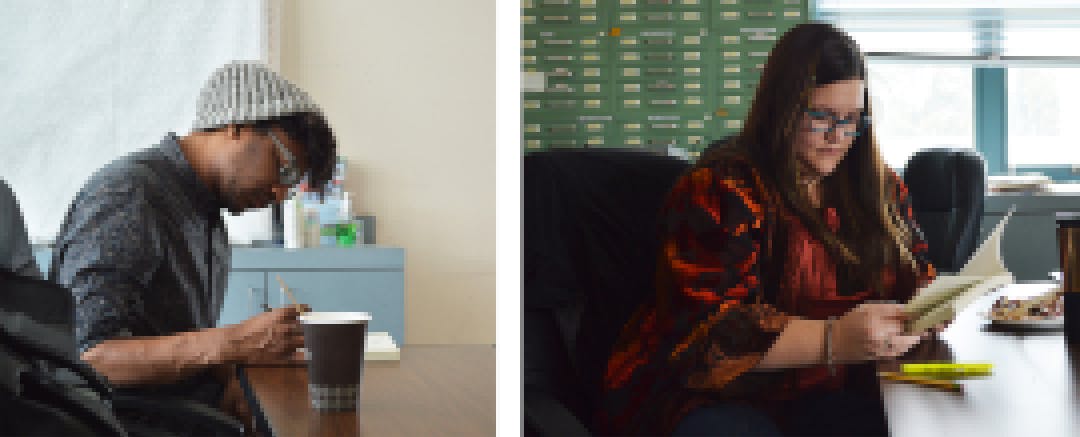David Peña-Guzmán starts off his Friday class at San Francisco State University like any other professor might: students file in and pull out their note-taking materials, and he opens his laptop to begin lecture.
But stay in Peña-Guzmán’s class a little longer—maybe five hours longer—and things start to look a little different. For starters, it’s long. The course, titled “The Reading Experiment: The Power of the Book,” takes place every other Friday beginning at 9:30 a.m. and wraps up at 2:30 p.m. There is also a snack table in the room that students contribute to and share, and a low ambient buzz emits from a white noise machine at the front.
For most of the course, there’s no lecture happening at all. Students put away their technology and read for four hours.
“It’s a rediscovery of uninterrupted reading,” Peña-Guzmán said last Friday while pulling up slides about the assigned readings.
Technology is allowed from 9:00 to 9:30 a.m., a non-mandatory part of class when Peña-Guzmán frames the day’s reading. This week, it’s Fyodor Dostoevsky’s “Notes From Underground,” an existential novella following a narrator who retreats from Russian society and, as the professor describes it, “puts himself in situations where he will make himself more miserable.”
After touching on the book’s themes and providing historical context, the professor walks around with what students have dubbed the “Bag of Despair,” a recycled plastic bag where all cell phones are kept for the remainder of the class period. Students find a comfortable spot in the room, make a plate with snacks, and start reading. The professor turns on the white noise machine to block out some creaks and other background noises from the building.

After 55 minutes of reading, students can get up to stretch or chat amongst themselves for five minutes, then they continue reading until the next break. There’s also a pause for lunch around noon. The last hour of class is dedicated to discussing the reading.
“It’s been unexpectedly hard,” said Adam Tejeda, a student in the class majoring in the humanities. “But I found it easier to make make connections in the reading, versus when I’m reading in chunks.”
Back to Basics
Peña-Guzmán researches the philosophy of science, technology and other subjects. And he wanted to shake things up in his teaching after noticing how hard it was for him to not reach for his phone while reading—a habit that his students said they also struggled with. “It’s so easy to get distracted with email or text messages,” he said. “It’s pervasive.”
He was inspired to design the class after reading about a religious studies course at University of Pennsylvania, where a professor wanted students to try to experience monastic life across different religions. Among the rules were vows to to detach from their electronics, spend no more than $50 per week, practice celibacy and only speak to an assigned partner in class. He actually reached out to that professor for feedback, and said he “decided to adapt it with some changes to fit our students and school.”
On the first day of class, students read an article in the Guardian about the ways that apps, social media and other technology are designed to grab and hold on to our attention. But the course wasn’t designed simply to digitally detox; it also intends to reflect the course’s focus on existentialism. “Existential thinking is partly about not fleeing from a task at hand, and deep reflection,” Peña-Guzmán said.
Since the semester started, the professor has heard from fellow faculty members curious about the course. One asked via email whether the 5-hour block allotted for the class was a typo.

One question he often gets is: How do you assess such a course? His answer is simply class participation, plus in-class and take-home writing assignments. For this week’s class, students were given a prompt: “What is the central character's highest virtue? What makes this extremely unlikeable character virtuous in his own way?” Using evidence from the text, the students will write a short piece answering that question.
Tech-No?
Debates over whether or not students should be allowed to use technology in class have bubbled for years. Some faculty members point to research showing how laptops can be more of a distraction than a learning enabler. Purdue University even started blocking streaming websites such as Netflix, HBO, Hulu and Pandora.
But others say banning laptops can be counterproductive, arguing these devices can create opportunity for students to discover more information during class or collaborate. And that certain tools and technologies are necessary for learners who struggle in a traditional lecture format.

Joelle Thomas, a master’s student in the reading class, teaches a course at the university, called “Values in American Life,” which looks at different types of art forms across American history. She encourages students to bring laptops, tablets or cell phones “so that they can get a closer look at digital images or follow along with their lyrics,” Thomas said.
But she likes the alternative approach to learning in Peña-Guzmán’s class. “Reading at home, it gets hard to focus. You get an email or a text and it’s hard to get back into it,” said Thomas. “This class helps me get through that.”
Peña-Guzmán’s reading course sounds like an extreme version of the tech-less side of the debate. But that’s not the case. “I’m by no means a luddite who thinks tech should be kept outside society or the academy,” he said. “But I do have concerns about making sure it’s us who are determining what place tech has in our lives, rather than some external force, and that’s tricky.”
He also points out that banning technology can disproportionately hurt groups of students. “When the syllabus says no laptops unless you have a disability, it automatically sort of outs those students,” he said. “This is also a [socioeconomic] class issue. A lot of students might not have resources to print out all the books or materials, so they rely on their phone to access course content.”
The professor sent an email to students before the course to ask about any concerns with the format or if anyone needed assistance purchasing the books. “If a student needs a screen or technology, we would get clever. It wouldn’t be an issue at all,” he said. “A ban on technology should never extend to that degree.”
Since the course started, there have been times when Peña-Guzmán forgot to collect students’ phones—so they reminded him. And the professor acknowledges there is a selection bias with which students signed up for the class.
Daylan Buchanan, a humanities major in the class, has had other professors adamant about putting technology away, calling it a distraction and asserting that handwriting can help retain information better. “I think it’s rude to pull out your phone in class, so I align with that,” says Buchanan. “But this class is an experiment in training to not divert our attention, and instilling a relationship with reading again.”
Students had plenty of concerns going into the course, too. Some were said they were afraid they couldn’t maintain attention to read for four hours, others said were worried about being the last one to finish, or not having enough to say about it during the discussion period.
Peña-Guzmán shared many of those feelings. So on the first day that the class met, the professor confronted their fears head-on, talking with students directly about the concerns they all had going into it. “I made it clear to students that this is not a race,” he said. “If you only get through half, I will see the class as a success at least in terms of its fundamental objective.” Students are encouraged to finish reading at home.
There are other challenges. Long course hours on a Friday may not be a viable option for students navigating busy schedules. San Francisco State is also a commuter campus, which could make driving a long distance to read seem unfeasible.
Peña-Guzmán has made some tweaks to the course already, like adding in the five-minute breaks. And he’s optimistic that the course will be offered again this year. In the meantime, the course will continue to evolve.
“We are learning as we go,” he said. Shortly after, Peña-Guzmán hit a small glitch with his slideshow, and students quickly chimed in with a solution. The professor joked: “See, that’s why I don’t use technology.”


